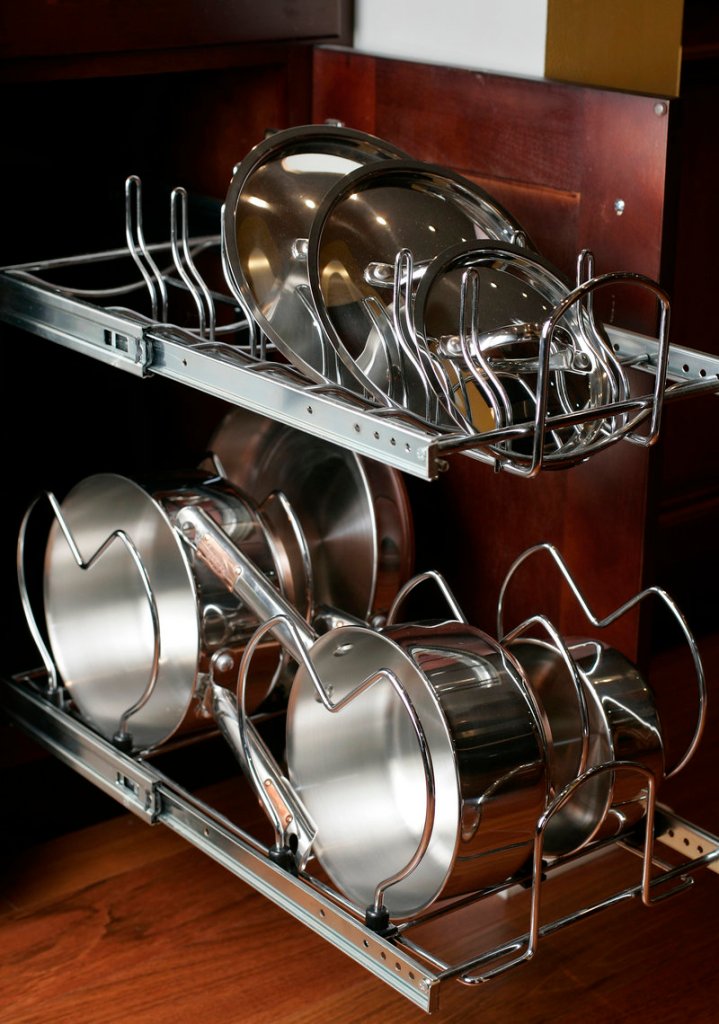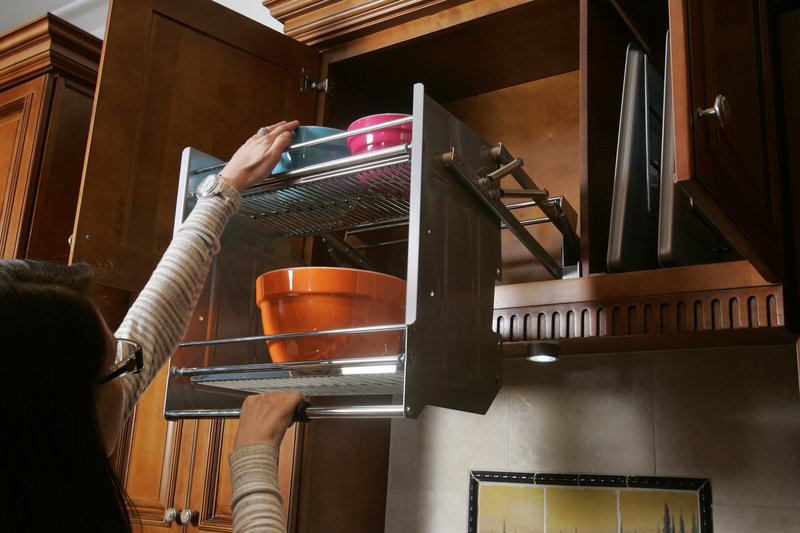KANSAS CITY, Mo. – It’s easy to get kitchen cabinet envy when you see the latest models with their shiny car-lacquer exteriors and hidden hinges. It’s no wonder painting cabinets or replacing the fronts is all the rage.
But it’s what’s behind the doors that matters most. This is where we store food, cookware, utensils and more. If you really want to get jealous, open drawers and doors of new cabinets with their fancy-pants slide-out pantries and dish racks.
“The problem with older cabinets is that they look like black holes inside,” says Krista Williamson, owner of K2 Workshops in Overland Park, Kan., which offers home-improvement classes. “No one wants to crawl through a dungeon.”
However, simple modifications, such as adding sliding shelves and rolling pullout drawers, can give existing cabinets new life, Williamson says. Upgrading what you have can save thousands of dollars versus replacement. She demonstrates the theory on a decades-old cabinet from Habitat ReStore, a nonprofit that sells previously owned building materials.
“This base cabinet had an upper shelf that just came out halfway,” she says. “It was for storing small appliances like a mixer and a blender. But the cabinet was kind of useless, because you still had to get down on your hands and knees. And a fourth of the storage space wasn’t being used.”
So Williamson removed the worthless shelf. She measured the width and depth of the cabinet interior and had a new shelf and reinforcements made with ¾-inch plywood cut at a home-improvement warehouse, securing it with silicone. She found Rev-a-Shelf wooden and metal pullouts from Lowe’s that would fit inside.
“It’s important to have the right measurements,” she says. The pullouts should be a half-inch less wide than your doors on either side. Sometimes they have to be special ordered. “Someone was returning some of the systems because they weren’t the right fit.”
In less than an hour, Williamson installed glides and turned the cabinet into a more useful one with pullouts that can be used for stacks of dishes or pots and pans. She prefers wooden drawers (“they’re more furniture like”), but metal ones can be more economical and space-efficient.
“Just be sure to get the sturdier metal ones,” Williamson cautions. “They’re not all created equally.”
Before investing in any products, take the time to clean and organize your kitchen cabinets. Kristi Pelzel, owner of the Organization People, categorizes everything into zones: spices, linens, foil/wrap. Consider it an opportunity to pare down.
“People usually have way too many glasses,” Pelzel says. “Donate the ones you don’t use. They shouldn’t be crammed inside. Leave breathing-room space between them.”
The same goes for leftover containers (limit two per person). And Pelzel suggests storing occasional pieces elsewhere, especially in a space-crunched kitchen.
“Put the turkey platter and the silver you use once a year in a box marked ‘Thanksgiving,”‘ Pelzel says. “They don’t need to take up precious real estate in the kitchen.”
Pelzel advocates using what you have for storage before buying more stuff. She likes using clear baggies because they’re space-efficient, and you can easily see what’s inside. They’re good for storing coupons, for example.
Kitchen cabinet organization systems have become a popular category. Materials include white polymer, brushed aluminum wire with chrome plating, birch and maple hardwoods, bamboo and rattan basket drawers. One of the most recent additions to kitchen organizational materials is clear glass for a more modern look, but it comes with a higher price tag.
One of the main things people struggle with is spice storage, says Geri Higgins, owner of Portfolio Kitchen & Home, a kitchen showroom in Kansas City. There are door-mount systems and drawer inserts, which can be good as long as they’re not placed above the cooktop, where the humidity will shorten the spice life.
Higgins separates the spices by sweet and savory and then arranges them alphabetically. A little Martha? Perhaps, but she has a lot of spices. She wishes she could go even further in organizing them.
“They need an app for spice expiration by bar code,” Higgins says. “They have wine-storage apps and new technology for expired food in the refrigerator, so why not for spices, too?”
Send questions/comments to the editors.




Success. Please wait for the page to reload. If the page does not reload within 5 seconds, please refresh the page.
Enter your email and password to access comments.
Hi, to comment on stories you must . This profile is in addition to your subscription and website login.
Already have a commenting profile? .
Invalid username/password.
Please check your email to confirm and complete your registration.
Only subscribers are eligible to post comments. Please subscribe or login first for digital access. Here’s why.
Use the form below to reset your password. When you've submitted your account email, we will send an email with a reset code.